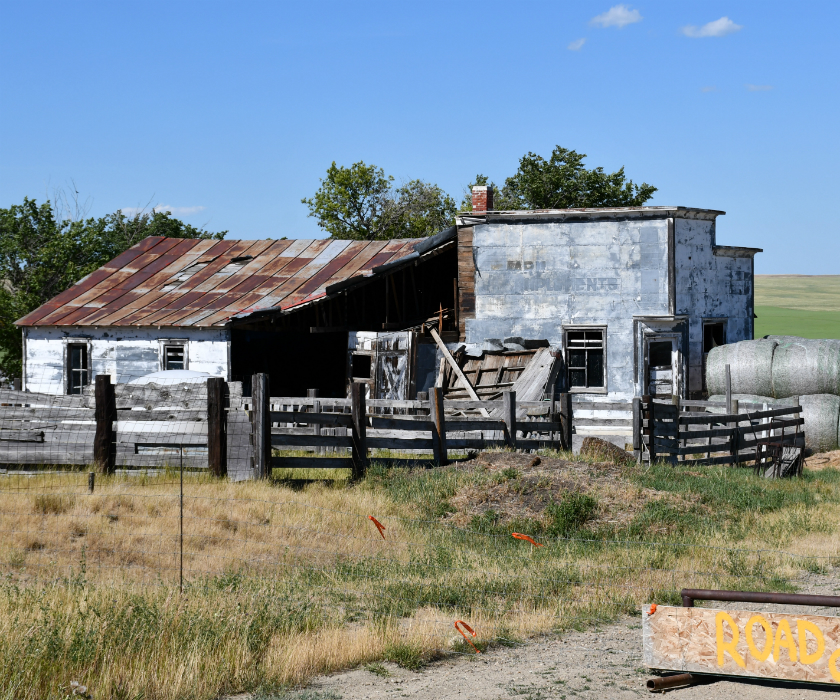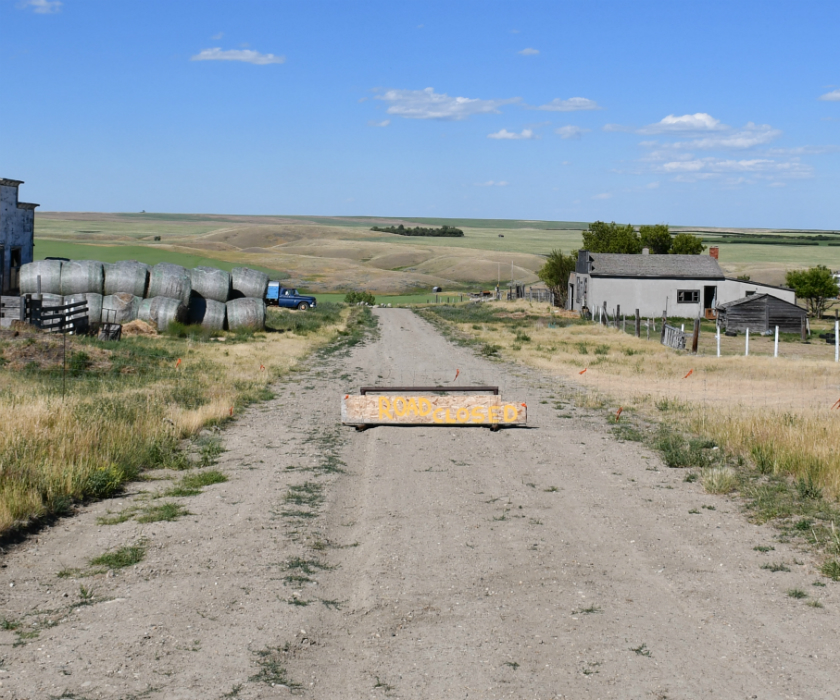Empty
“It doesn’t make sense that I be here,” Aime Lacelle said. “But still I am.”
Lacelle looks out the window of his small home on top of the hill. He sees the sandbox his father made for him to play in as a child, and the swing set made from two old telephone poles stuck into the ground.
But Lacelle can only see them in his memories. Out the window of his living room, there is an empty space where his childhood home used to be.
“Little children, they get attached to where they grew up,” he said. “The first things that they see and understood around them in their little lives, that’s a basic thing that happens to anyone. That happened to me.”
The town of Crichton was once a bustling service town for the area, back in the 1930s and 1940s. There were three grain elevators and all the local necessities: a general store; a café; and a post office. A big warehouse in the town was used for town dances and other community activities, and even a diamond for baseball games.
Lacelle recalled a story that his father told him about how he came to run the general store in town. Lacelle was about two at the time and his father still lived in the nearby town of Cadillac and worked at the grocer’s. One day his father ran into the local priest.
The priest passed on some sad news to the elder Lacelle: the general store owner from Crichton had passed away the night before and his body was being taken to the nearest synagogue for the proper last rites. But the store owner also had responsibilities as the postmaster for the area. One of his duties was to meet the passenger train twice a day, five days a week.
According to Lacelle, the priest asked his father if he’d be interested in buying the Crichton store. Lacelle’s father replied that he would be, but he couldn’t afford it.
“And Father Russo, he says ‘well, get in your truck and go up there and get the mail bag and meet the train, and the place is yours. I’ll buy it for you and you pay me back whenever you can,” Lacelle said. “And … that’s what Dad did.”
Crichton once competed with nearby communities like Cadillac and Admiral as a major hub, Lacelle said. But while those other towns still live on, Crichton has diminished. Lacelle is the only one left.
And his childhood home is a hole in the ground.
“I was raised in the building that just isn’t there anymore,” he said. “There’s just the hole.”
To most of the rest of the world, Crichton doesn’t actually exist anymore. The “town” has long since lost its status as an independent body and is now governed by the reeve of the area’s rural municipality.

According to an email from the provincial government of Saskatchewan, the decline of settlements goes in stages: from town then to village and finally to unincorporated community. Once a community loses its status as a village, the population is counted in the area’s rural municipality. It’s one of the reasons people like Aime Lacelle in places like Crichton can be so difficult to find.
In Saskatchewan, The Municipalities Act outlines two possible definitions of a hamlet. The first is a community with at least five separate occupied dwellings and at least “ten divided lots” that average under an acre in size. The second is if the Minister of Government Relations — the branch of government that administers The Municipalities Act — simply deems an unincorporated area to be considered a hamlet.
So the question remains, what happens to places like Crichton, which no longer meet the official criteria to be considered a hamlet but is the remnant of a community that used to be there?
An economist for the Government of Saskatchewan said in an email that once a community becomes unincorporated (small enough or dispersed enough that it is absorbed by a rural municipality, like organized or unorganized hamlets), it can still be listed as a “designated place.”
A designated place is defined by Statistics Canada as “normally a small community or settlement that does not meet the criteria established by Statistics Canada to be a census subdivision or a population centre.” They are created by provinces individually to help provide data to Statistics Canada.
According to the email from the Government of Saskatchewan, it’s when a community has been dropped from the official list of designated places that it can truly be considered a “ghost town.” Statistics Canada has kept a list of designated places since 1996 that is updated in the census every five years.

Saskatchewan doesn’t have the most — it’s ranked fourth in total designated places of all the provinces with 193 as of the last census. But 80 of those places have a population of 20 people or fewer. The next closest province, British Columbia, only has 34 designated places that small.
And Crichton — Lacelle’s childhood home and current residence — isn’t on any of the lists of designated places since 1996. It’s been considered a non-entity by the government for more than two decades.
Neither is Scotsguard, the final home of Keith and Beverly Hagen. Or Ramona Schoettler’s birthplace of Romance, now reduced to an empty field. Nor is Spruce Home, the town Schoettler lives in now. Meyronne has been on the list since they started keeping track in 1996, which means that town’s time left is limited, too.
That’s the reality that awaits a lot of these towns: total obscurity, and little to remember them by.
The last one left
Standing in front of the remains of his birthplace, Lacelle looks like he’s stepped out of a history book. Adorned in blue jeans and a button-down shirt with a Stetson on his head, the man is a picture of the stereotypical farmer that settled Canada.
As Lacelle looks out over the remains of his hometown, he isn’t as emotional as Caryl Watts in Meyronne or as impassioned as Keith Hagen in Scotsguard. He’s actually quite calm. Resigned. Leaning against the old fence next to his house, he sees what Crichton was, not what it’s become.
“You know, I can, with my eyes open or closed, I can remember places,” he said. “Where I’ve driven with a tractor on certain parcels of land around here. Or pastures that I’ve ridden with a horse. Or places where I’ve walked. And that all generates feeling.”
But that’s where the picture ends. The house Lacelle was born in has been reduced to some bits of old foundation marking the rectangle on the ground where the walls once stood. Across the main street is the old grain agent’s building, now a makeshift garage for Lacelle. A flock of sheep belonging to his nearby neighbour meanders down main street, where the road has been closed off with a ramshackle sign.
Past the sign and down the hill is the old railway track covered with weeds and grass, next to the remains of whatever station Crichton would have had.
The best parts of the town that are still left standing are in the imagination of the solitary man that remembers them, alone on the hill. When Lacelle is gone, the only thing left will be the monument down near the highway, commemorating the community that was.
For now, Lacelle has his memories. And that’s enough.
“…with my eyes open or closed, I can remember places.””
“My emotional connection … over the years, it just kept building up,” he said. “Even though it doesn’t make sense that I be here, that accounts for the fact that, you know, I’m content here.”
Lacelle paused for a moment, then chuckled.
“It feels interesting. It’s amazing.”
“It feels interesting. It’s amazing.”